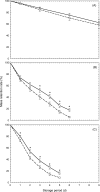Efficient preservation of sprouting vegetables under simulated microgravity conditions
- PMID: 33057413
- PMCID: PMC7561153
- DOI: 10.1371/journal.pone.0240809
Efficient preservation of sprouting vegetables under simulated microgravity conditions
Abstract
The effectiveness of a simulated microgravity environment as a novel method for preserving the freshness of vegetables was investigated. Three types of vegetables were selected: vegetable soybean, mung bean sprouts, and white radish sprouts. These selected vegetables were fixed on a three-dimensional rotary gravity controller, rotated slowly. The selected vegetables were stored at 25°C and 66% of relative humidity for 9, 6, or 5 d while undergoing this process. The simulated microgravity was controlled utilizing a gravity controller around 0 m s-2. The mung bean sprouts stored for 6 d under simulated microgravity conditions maintained higher thickness levels than the vegetable samples stored under normal gravity conditions (9.8 m s-2) for the same duration. The mass of all three items decreased with time without regard to the gravity environment, though the samples stored within the simulated microgravity environment displayed significant mass retention on and after 3 d for mung bean sprout samples and 1 d for white radish sprout samples. In contrast, the mass retention effect was not observed in the vegetable soybean samples. Hence, it was confirmed that the mass retention effect of microgravity was limited to sprout vegetables. As a result of analysis harnessing a mathematical model, assuming that the majority of the mass loss is due to moisture loss, a significant difference in mass reduction coefficient occurs among mung bean sprouts and white radish sprouts due to the microgravity environment, and the mass retention effect of simulated microgravity is quantitatively evaluated utilizing mathematical models. Simulated microgravity, which varies significantly from conventional refrigeration, ethylene control, and modified atmosphere, was demonstrated effective as a novel method for preserving and maintaining the freshness of sprout vegetables. This founding will support long-term space flight missions by prolonging shelf life of sprout vegetables.
Conflict of interest statement
We have the following interests: Yumi Kawahara is the president of Space Bio-laboratories Co., Ltd. There are no patents, products in development or marketed products to declare. This does not alter our adherence to all the PLOS ONE policies on sharing data and materials, as detailed online in the guide for authors.
Figures





Similar articles
-
Dynamics of bacterial communities in alfalfa and mung bean sprouts during refrigerated conditions.Food Microbiol. 2019 Dec;84:103261. doi: 10.1016/j.fm.2019.103261. Epub 2019 Jul 6. Food Microbiol. 2019. PMID: 31421775
-
Behavior of enteroaggregative Escherichia coli, non-O157-shiga toxin-producing E. coli, enteroinvasive E. coli, enteropathogenic E. coli and enterotoxigenic E. coli strains on mung bean seeds and sprout.Int J Food Microbiol. 2013 Sep 16;166(3):364-8. doi: 10.1016/j.ijfoodmicro.2013.08.008. Epub 2013 Aug 19. Int J Food Microbiol. 2013. PMID: 24021821
-
Pathogen reduction on mung bean reduction of Escherichia coli O157:H7, Salmonella enterica and Listeria monocytogenes on mung bean using combined thermal and chemical treatments with acetic acid and hydrogen peroxide.Food Microbiol. 2018 Dec;76:62-68. doi: 10.1016/j.fm.2018.04.008. Epub 2018 Apr 18. Food Microbiol. 2018. PMID: 30166191
-
Simulated microgravity: critical review on the use of random positioning machines for mammalian cell culture.Biomed Res Int. 2015;2015:971474. doi: 10.1155/2015/971474. Epub 2015 Jan 14. Biomed Res Int. 2015. PMID: 25649075 Free PMC article. Review.
-
Plant responses to real and simulated microgravity.Life Sci Space Res (Amst). 2021 Feb;28:74-86. doi: 10.1016/j.lssr.2020.10.001. Epub 2020 Oct 10. Life Sci Space Res (Amst). 2021. PMID: 33612182 Review.
Cited by
-
Mechanism for enhancing the growth of mung bean seedlings under simulated microgravity.NPJ Microgravity. 2021 Jul 15;7(1):26. doi: 10.1038/s41526-021-00156-6. NPJ Microgravity. 2021. PMID: 34267213 Free PMC article.
References
-
- Food and Agriculture Organization of the United Nations, The State of Food Security and Nutrition in the World. 2019 7 1 [Cited 6 August 2020] http://www.fao.org/3/ca5162en/ca5162en.pdf.
-
- Food and Agriculture Organization of the United Nations, Global Food Losses and Food Waste. 2011 5 16 [Cited 6 August 2020] http://www.fao.org/3/a-i2697e.pdf.
-
- Kailasapathy K, Koneshan T. Effect of wilting on the ascorbate content of selected fresh green leafy vegetables consumed in Sri Lanka. J Agr Food Chem. 1986; 34: 259–261.
-
- Li H, Chen Y, Zhang ZQ, Li BQ, Qin GZ, Tian SP. Pathogenic mechanisms and control strategies of Botrytis cinerea causing post-harvest decay in fruits and vegetables. Food Qual Safety. 2018; 2: 111–119.
Publication types
MeSH terms
LinkOut - more resources
Full Text Sources
Research Materials

